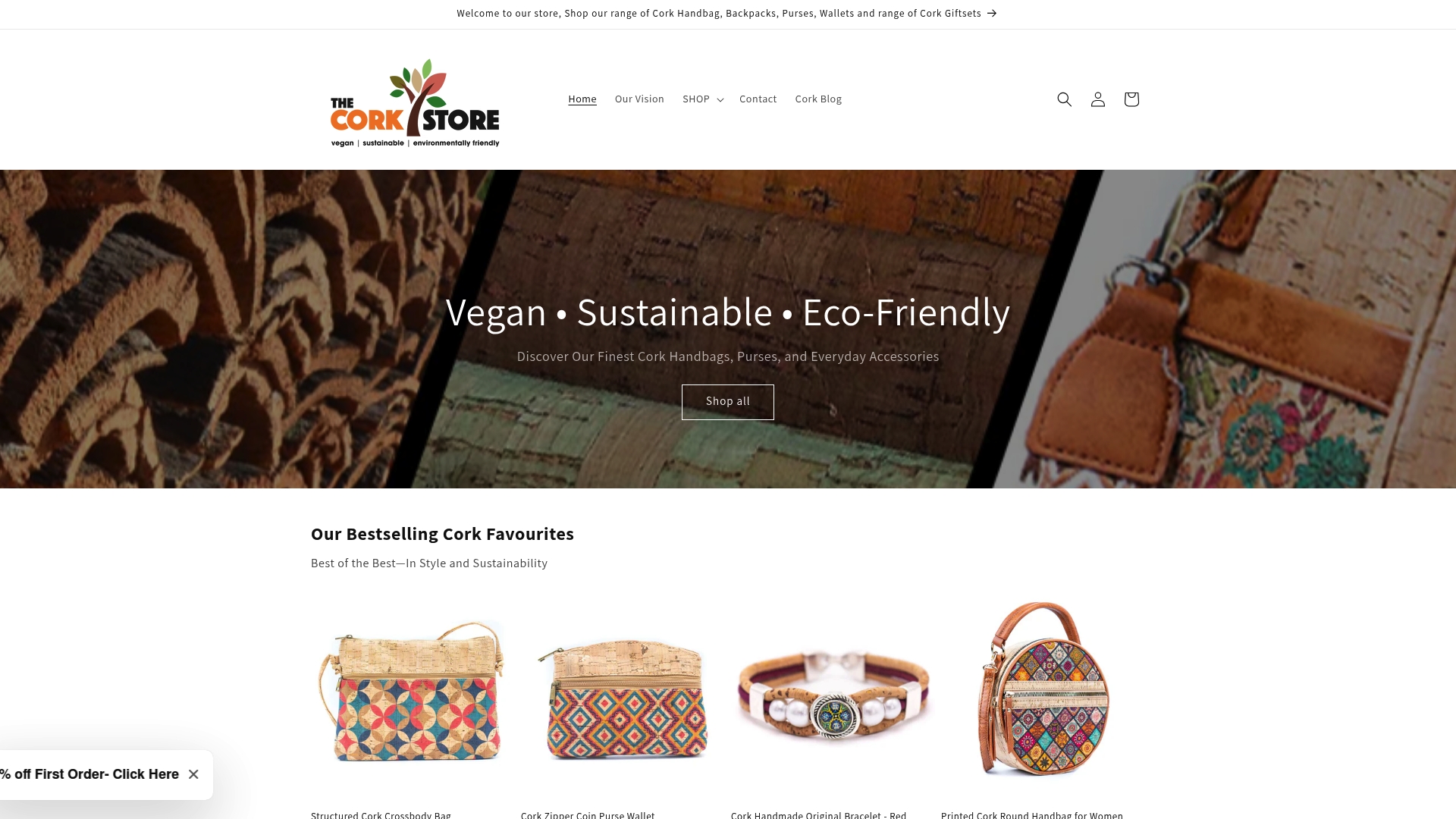
7 Amazing Examples of Sustainable Handbags You’ll Love
Share
Sustainable handbags are turning heads for all the right reasons. People often assume eco-friendly fashion means sacrificing style or choice, yet the fashion industry is responsible for a staggering share of global waste and resource depletion. What surprises many is this. Choosing a sustainable handbag is no longer about settling for less. It is about carrying a lasting accessory that blends sharp design with environmental purpose.
Table of Contents
- Introduction To Sustainable Handbags
- Organic Cotton: A Versatile Option
- Recycled Materials: Stylish And Eco-Friendly
- Vegan Leather: Animal-Friendly Alternatives
- Upcycled Handbags: Giving Old Materials New Life
- Fair Trade Handbags: Supporting Ethical Practices
- Innovative Brands To Explore
Quick Summary
| Takeaway | Explanation |
|---|---|
| Sustainable handbags prioritise eco-friendliness | They use innovative materials and ethical production to reduce environmental impact in fashion. |
| Organic cotton reduces ecological harm | Its cultivation conserves resources, decreases chemicals, and minimizes water consumption, promoting sustainability. |
| Recycled materials create unique designs | Handbags made from waste materials reduce waste, lower carbon emissions, and offer distinctive aesthetics. |
| Vegan leather is a compassionate choice | It eliminates animal exploitation while providing stylish, durable alternatives that are environmentally friendly. |
| Fair trade supports ethical production | These handbags ensure artisanal workers receive fair wages, safe working conditions, and uphold cultural heritage. |
1: Introduction to Sustainable Handbags
Sustainable handbags represent a transformative approach to fashion accessories that prioritizes environmental responsibility and ethical production. As consumers become increasingly aware of the fashion industry’s ecological footprint, these innovative accessories are redefining how we think about style, functionality, and planetary impact.
The rise of sustainable handbags is driven by critical environmental challenges within traditional manufacturing processes. According to research from the Ellen MacArthur Foundation, the textile and accessories industry contributes significantly to global waste and resource depletion. Sustainable handbags offer a compelling alternative by embracing principles that minimise environmental harm.
Key characteristics of sustainable handbags include:
- Innovative Materials: Utilising recycled, organic, and renewable resources
- Ethical Production: Supporting fair labour practices and reducing carbon emissions
- Long-lasting Design: Creating durable accessories that transcend seasonal trends
These accessories go beyond mere fashion statements. They represent a commitment to conscious consumption, challenging traditional manufacturing paradigms by proving that style and sustainability can coexist harmoniously. By choosing sustainable handbags, consumers actively participate in reducing environmental impact while supporting brands that prioritise ethical production methods.
The global shift towards sustainable fashion is not just a trend but a necessary evolution. As the OECD highlights, sustainable accessories contribute directly to United Nations Sustainable Development Goals, addressing critical environmental and social challenges.
In the following sections, we will explore remarkable examples of sustainable handbags that demonstrate how innovative design, responsible sourcing, and environmental consciousness can create truly exceptional accessories.
2: Organic Cotton: A Versatile Option
Organic cotton has emerged as a powerful solution in the sustainable handbag landscape, offering an environmentally responsible alternative to conventional textile production. Unlike traditional cotton manufacturing, organic cotton cultivation minimises ecological harm and provides a renewable resource for creating stylish, durable accessories.
Environmental Benefits
According to research published in the International Journal of Environmental Research and Public Health, organic cotton production delivers significant ecological advantages that extend far beyond traditional textile manufacturing processes.
Key environmental advantages include:
- Reduced chemical usage in agricultural practices
- Preservation of soil biodiversity
- Lower water consumption compared to conventional cotton farming
- Decreased greenhouse gas emissions
Organic cotton handbags represent more than just a fashion statement. They embody a commitment to sustainable manufacturing that respects both environmental ecosystems and human health. By choosing accessories crafted from organic cotton, consumers actively support agricultural practices that prioritise ecological balance and responsible resource management.
The versatility of organic cotton makes it an ideal material for handbag production. Its natural fibres can be woven into various textures and designs, accommodating different aesthetic preferences while maintaining robust environmental credentials. From lightweight tote bags to structured messenger bags, organic cotton provides designers with remarkable flexibility in creating sustainable accessories.
Moreover, organic cotton handbags often feature additional eco-friendly characteristics. Many manufacturers integrate natural dyes, recycled hardware, and minimalist design principles to further reduce environmental impact. This holistic approach transforms these accessories from simple fashion items into powerful statements of environmental consciousness.
Consumers seeking sustainable fashion choices will find organic cotton handbags offer an excellent blend of style, durability, and environmental responsibility. By selecting these accessories, individuals can make meaningful contributions to reducing the fashion industry’s ecological footprint while enjoying high-quality, aesthetically pleasing products.
3: Recycled Materials: Stylish and Eco-Friendly
Recycled materials have revolutionised sustainable handbag design, transforming waste into beautiful, functional accessories that challenge traditional manufacturing paradigms. By reimagining discarded materials as valuable resources, designers are creating innovative handbags that tell powerful environmental stories.
The concept of recycled material handbags goes beyond simple waste reduction. These accessories represent a comprehensive approach to circular fashion, where materials are continuously repurposed and given new life. From plastic bottles to industrial textiles, recycled materials offer unprecedented opportunities for creative and sustainable accessory production.
Key advantages of recycled material handbags include:
- Significant reduction in global waste streams
- Lower carbon emissions compared to virgin material production
- Creative transformation of potential landfill items
- Unique aesthetic qualities derived from innovative recycling processes
Recycled plastic represents a particularly compelling material for sustainable handbag manufacturing. Research from the Sustainability journal demonstrates how post-consumer plastics can be effectively transformed into durable, water-resistant fabrics suitable for high-quality accessories.
Manufacturers are developing increasingly sophisticated techniques to convert waste materials into premium handbag textiles. Plastic bottles can be cleaned, shredded, and spun into robust fabric yarns, while industrial waste like discarded fishing nets and packaging materials are similarly repurposed into innovative textile solutions.
Beyond environmental benefits, recycled material handbags offer consumers unique design opportunities. Each accessory becomes a statement piece, reflecting individual commitment to sustainability while showcasing extraordinary craftsmanship. The textures, colours, and patterns emerging from recycled materials often provide more interesting and distinctive aesthetics than conventional manufacturing approaches.
Contemporary consumers increasingly seek accessories that align with their environmental values. Recycled material handbags fulfill this demand by offering stylish, functional products that demonstrate a genuine commitment to reducing global waste and promoting responsible consumption.
4: Vegan Leather: Animal-Friendly Alternatives
Vegan leather represents a groundbreaking approach to accessory manufacturing, offering compassionate consumers stylish alternatives that eliminate animal exploitation while addressing significant environmental concerns. These innovative materials transform the traditional leather industry by providing cruelty-free options that do not compromise on quality or aesthetic appeal.
Modern vegan leather technologies have evolved dramatically, moving far beyond basic synthetic substitutes. According to research in The International Journal of Life Cycle Assessment, contemporary vegan leather materials are increasingly sophisticated, drawing from diverse renewable and recycled resources.
Key characteristics of advanced vegan leather alternatives include:
- Elimination of animal products and byproducts
- Reduced environmental impact compared to traditional leather
- Innovative material sourcing from plants, recycled plastics, and organic compounds
- Enhanced durability and performance
Sustainable sourcing has become a critical focus in vegan leather production. Manufacturers are exploring remarkable materials like pineapple leaf fibers, cork, apple waste, and mushroom-derived textiles. These innovative approaches not only create stunning handbag materials but also provide economic opportunities for agricultural communities.
The environmental benefits of vegan leather extend beyond animal welfare. By utilizing alternative production methods, these materials often require significantly less water, generate fewer carbon emissions, and create opportunities for circular economy principles. Designers are increasingly demonstrating that ethical fashion can be both beautiful and environmentally responsible.
Consumers seeking vegan leather handbags now have access to an unprecedented range of textures, colours, and styles. From sleek, minimalist designs to intricate, artisanal creations, these accessories prove that compassionate choices need not compromise on style or quality.
Moreover, the ongoing technological innovations in vegan leather production suggest a promising future for sustainable fashion. As research continues and consumer demand grows, these materials will likely become even more sophisticated, offering increasingly compelling alternatives to traditional leather manufacturing.
5: Upcycled Handbags: Giving Old Materials New Life
Upcycled handbags represent a revolutionary approach to sustainable fashion, transforming discarded materials into extraordinary accessories that challenge traditional manufacturing paradigms. These innovative designs breathe new life into items that would otherwise contribute to global waste streams, demonstrating the incredible potential of creative reimagination.
Research from the OECD underscores the critical role of upcycling in sustainable materials management, highlighting how these creative processes can significantly reduce environmental impact while generating unique, valuable products.
Key advantages of upcycled handbags include:
- Dramatic reduction of waste in landfills
- Minimal additional resource consumption
- Creation of truly unique, one-of-a-kind accessories
- Preservation of materials with existing embedded energy
Upcycling goes beyond simple recycling by transforming discarded materials into products of higher quality and artistic value. Designers are discovering remarkable sources for handbag materials, including vintage textiles, industrial remnants, retired seatbelts, decommissioned parachutes, and even abandoned bicycle inner tubes. Each material brings its own narrative and character, creating accessories that are both environmentally responsible and aesthetically compelling.
The process of upcycling requires significant creativity and technical skill. Designers must carefully deconstruct existing materials, assess their structural integrity, and reimagine their potential. This approach demands a nuanced understanding of textile properties, design principles, and sustainable manufacturing techniques.
Consumers attracted to upcycled handbags are typically seeking more than just an accessory. They desire a statement piece that reflects personal values of environmental consciousness, creativity, and rejection of disposable fashion culture. Each upcycled handbag becomes a wearable narrative of resourcefulness and innovation.
Moreover, upcycled handbags contribute to a broader conversation about consumption patterns. By demonstrating the potential of existing materials, these accessories challenge consumers to reconsider waste, view discarded items as resources, and embrace more circular approaches to fashion and design.
6: Fair Trade Handbags: Supporting Ethical Practices
Fair trade handbags represent a powerful intersection of ethical production, social responsibility, and sustainable fashion. These accessories go far beyond aesthetic appeal, embodying a profound commitment to supporting artisan communities, preserving traditional craftsmanship, and ensuring equitable economic opportunities.
Research from the JungleVine Foundation demonstrates how fair trade practices can transform local economies while maintaining cultural integrity and environmental sustainability. These principles ensure that every handbag tells a story of empowerment and respect.
Key principles of fair trade handbag production include:
- Guaranteeing living wages for artisan workers
- Providing safe, dignified working conditions
- Supporting traditional crafting techniques
- Ensuring transparent, ethical supply chains
- Promoting gender equality in workplace environments
Ethical production means more than simply paying fair wages. It encompasses a holistic approach to supporting artisan communities, respecting cultural traditions, and creating sustainable economic opportunities. Fair trade handbags often emerge from regions with rich textile histories, where traditional crafting techniques have been passed through generations.
Unique characteristics distinguish fair trade handbags from mass-produced accessories. Each piece reflects the individual skill and cultural heritage of its creators, featuring intricate details, authentic materials, and a connection to human stories that industrial manufacturing cannot replicate.
Consumers choosing fair trade handbags are making a profound statement about their values. They demonstrate a commitment to global economic justice, recognising that their purchasing decisions can directly impact communities worldwide. These accessories become more than fashion items they are tangible expressions of solidarity and support.
Moreover, fair trade practices often incorporate additional sustainable principles. Many artisan groups prioritize environmentally friendly materials, traditional production methods with minimal carbon footprint, and techniques that preserve both cultural knowledge and ecological balance.
7: Innovative Brands to Explore
The sustainable handbag landscape is continuously evolving, with innovative brands pushing boundaries and redefining what ethical fashion means. These forward-thinking companies demonstrate that environmental responsibility and aesthetic excellence can coexist harmoniously, offering consumers sophisticated alternatives to traditional accessory manufacturing.
Consumers seeking sustainable handbags now have unprecedented opportunities to support brands that prioritize ecological and social consciousness. These manufacturers are not merely creating accessories they are challenging entire industry paradigms through creative, principled approaches to design and production.
Key considerations when exploring innovative sustainable handbag brands include:
- Transparency in material sourcing
- Commitment to ethical manufacturing processes
- Innovative approaches to waste reduction
- Design that balances functionality with environmental responsibility
- Proven track record of social and ecological impact
The most compelling sustainable handbag brands share several critical characteristics. They view environmental stewardship not as a marketing strategy, but as a fundamental operational philosophy. These brands invest significant resources in research and development, continuously seeking materials and production methods that minimise ecological harm while maximising aesthetic and functional value.
Designers are increasingly exploring unconventional materials, transforming agricultural waste, recycled plastics, and discarded industrial textiles into stunning accessories. This approach represents more than environmental responsibility it is a creative revolution challenging traditional manufacturing assumptions.
Consumers can now choose handbags that tell complex stories of innovation, craftsmanship, and global responsibility. Each purchase becomes an active statement of support for more sustainable, equitable fashion ecosystems. By selecting accessories from brands committed to meaningful change, individuals contribute to a broader movement reimagining how fashion can positively impact our world.
The future of sustainable handbags is not about compromise. It is about creating beautiful, functional accessories that honour both human creativity and planetary well-being.
The following table provides a concise summary of the article, highlighting the main types of sustainable handbags, their key benefits, and important considerations for environmentally responsible accessory choices.
| Example / Approach | Description | Key Benefits & Outcomes |
|---|---|---|
| Organic Cotton | Handbags made from organically grown cotton, using fewer chemicals and less water. | Reduces environmental impact, supports sustainable agriculture, versatile |
| Recycled Materials | Bags created from post-consumer plastics, textiles, or other repurposed waste. | Lowers landfill waste, unique designs, promotes circular fashion |
| Vegan Leather | Accessories crafted from plant-based or recycled alternatives to animal leather. | Animal-friendly, reduced water & carbon footprint, innovative materials |
| Upcycled Handbags | Transforming discarded fabrics and materials into high-value, one-of-a-kind accessories. | Minimises resource use, preserves unique material stories, creative reuse |
| Fair Trade Handbags | Ethically produced by artisans, ensuring fair wages, safe working conditions, and cultural preservation. | Supports social equity, preserves craft traditions, transparent sourcing |
| Innovative Brands | Companies leading in eco-conscious sourcing, design, and transparency. | Advances industry standards, fosters new solutions, aligns with values |
| Overall Impact | Adopting these approaches supports a shift towards more ethical, durable, and environmentally friendly fashion. | Reduces waste, empowers artisans, aligns style with sustainability |
Discover Sustainable Cork Handbags: Style Meets Real Impact
Are you inspired by the promise of truly sustainable fashion? If the problems of environmental harm, waste, and the desire for ethical alternatives discussed in “7 Amazing Examples of Sustainable Handbags You’ll Love” resonate with you, it is time to take action. This article lays bare the pain points of excess waste, harmful practices in traditional manufacturing, and the ongoing search for handbags that match your style without compromising your values. By focusing on recycled materials, vegan leather, and fair working conditions, the article showcases your need for fashion that is both beautiful and responsibly made.

Experience the true difference with The Cork Store where every handbag is crafted from cork, offering a vegan, eco-conscious replacement for animal leather. Enjoy stylish and cruelty-free accessories that support your choice to shop ethically and minimise your environmental footprint. Discover our carefully selected range of bestselling sustainable cork handbags and make your commitment to the planet visible every day. Visit now and find the accessory that reflects your values and your style before our most popular pieces are gone.
Frequently Asked Questions
What materials are commonly used in sustainable handbags?
Sustainable handbags often use innovative materials such as organic cotton, recycled plastics, vegan leather, and upcycled fabrics. These materials prioritise environmental responsibility and ethical production.
How do organic cotton handbags contribute to sustainability?
Organic cotton handbags reduce chemical usage, conserve water, and promote soil health, making them a more eco-friendly option compared to conventional cotton. They also support sustainable agricultural practices.
What are the benefits of choosing vegan leather handbags?
Vegan leather handbags offer cruelty-free alternatives to traditional leather, often using materials from renewable sources and requiring less water and resources during production. They maintain high durability and aesthetic appeal without animal exploitation.
How does upcycling differ from recycling in handbag production?
Upcycling transforms discarded materials into higher quality accessories, preserving their value and reducing waste significantly. In contrast, recycling involves breaking down materials to create new products, which may not retain the same quality or unique character.
